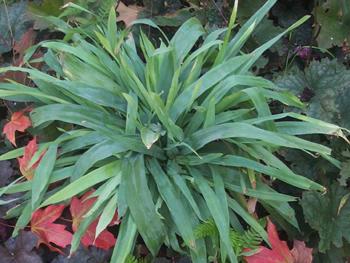General Description
Bloom Description: Blooms June into August. Green inflorescences are held on long, arching stalks. They are not showy.
Growth Habit & Shape: Carex platyphylla creates a broad mound of foliage.
Soil Preferences: Average to dry, often found in high pH soils.
Root Description: Carex platyphylla has a fibrous root system.
Garden Uses: Shade gardens, dry shade, especially under deciduous trees.
Best Management & Maintenance: Low maintenance. Flower stalks can be cut back for tidier appearance.
Common Problems: None.
Benefits
Ornamental Value: The broad, bluish leaves of this sedge add interest to just about any shady garden bed. Provides visual interest in shady spots when few things are blooming.
Wildlife Benefits: Various insects feed on the foliage of sedges (Carex spp.). Broadleaf sedge in particular hosts species of Satyr larvae.
Other Practical/Environmental Benefits:
Use in place of: Miniature hostas.
Ecology
Habitat:
Carex platyphylla inhabits deciduous forests, often on high pH bedrock.
Response to Disturbance: Drought tolerant.
Native State Distributions:
Canada: CAN: MB, NB, ON, QC, SKU
USA: AL, AR, CT, DC, DE, FL, GA, IA, IL, IN, KS, KY, MA, MD, ME, MI, MN, MO, MS, NC, ND, NE, NH, NJ, NY, OH, OK, PA, RI, SC, SD, TN, TX, VA, VT, WI, WV
Wetland indicator status: Not classified.
Companion Plants:
Creeping phlox (Phlox stolonifera), foam-flower (Tiarella cordifolia), white wood-aster (Eurybia divaricata)
References
Return to Top

